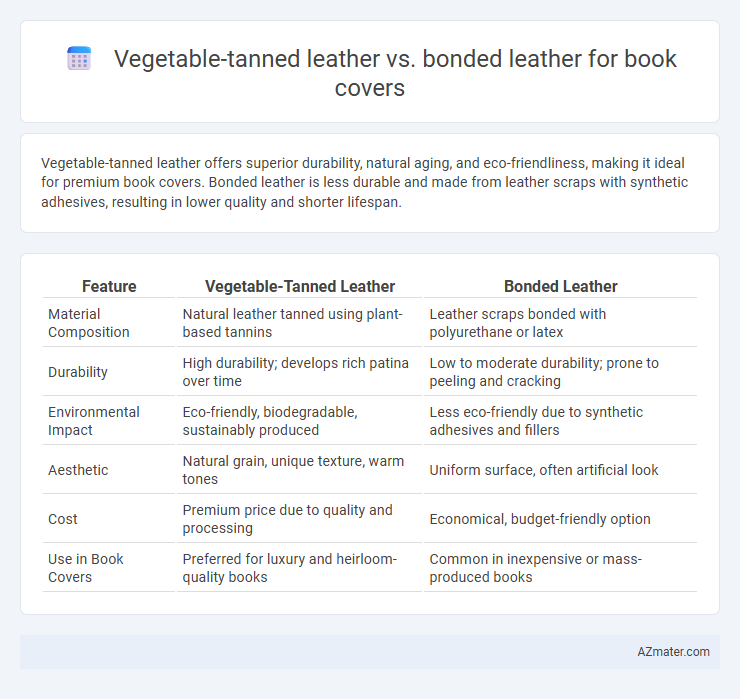Vegetable-tanned leather offers superior durability, natural aging, and eco-friendliness, making it ideal for premium book covers. Bonded leather is less durable and made from leather scraps with synthetic adhesives, resulting in lower quality and shorter lifespan.
Table of Comparison
| Feature | Vegetable-Tanned Leather | Bonded Leather |
|---|---|---|
| Material Composition | Natural leather tanned using plant-based tannins | Leather scraps bonded with polyurethane or latex |
| Durability | High durability; develops rich patina over time | Low to moderate durability; prone to peeling and cracking |
| Environmental Impact | Eco-friendly, biodegradable, sustainably produced | Less eco-friendly due to synthetic adhesives and fillers |
| Aesthetic | Natural grain, unique texture, warm tones | Uniform surface, often artificial look |
| Cost | Premium price due to quality and processing | Economical, budget-friendly option |
| Use in Book Covers | Preferred for luxury and heirloom-quality books | Common in inexpensive or mass-produced books |
Introduction to Book Cover Materials
Vegetable-tanned leather offers durability, natural aging, and a rich, authentic texture ideal for high-quality book covers, ensuring longevity and a premium feel. Bonded leather, made from leather scraps bonded with polyurethane, provides cost-effectiveness and a consistent appearance but lacks the durability and unique character of vegetable-tanned leather. Choosing vegetable-tanned leather enhances the tactile experience and value of book covers, while bonded leather suits budget-conscious projects requiring a leather-like aesthetic.
What is Vegetable-Tanned Leather?
Vegetable-tanned leather is a natural material processed using tannins derived from plant sources like tree bark and leaves, resulting in a durable and eco-friendly book cover option. Unlike bonded leather, which is made from leather scraps mixed with adhesives, vegetable-tanned leather offers superior aging characteristics, developing a rich patina over time. Its breathable and sturdy nature ensures long-lasting protection for books while maintaining a premium, authentic feel.
What is Bonded Leather?
Bonded leather is a material made by combining shredded leather fibers with polyurethane or latex onto a fiber backing, creating a cost-effective alternative to genuine leather. Unlike vegetable-tanned leather, which is crafted from whole hides treated with tannins from plant sources, bonded leather lacks the natural durability, breathability, and aging characteristics essential for long-lasting book covers. Book covers made from bonded leather often show signs of peeling and wear faster due to the synthetic binding, whereas vegetable-tanned leather develops a unique patina and provides superior protection for valuable books.
Durability: Vegetable-Tanned vs Bonded Leather
Vegetable-tanned leather offers superior durability compared to bonded leather, as it is made from whole animal hides that resist wear and tear over time. Bonded leather, composed of leather scraps bonded with adhesive, tends to peel and crack more easily under frequent use, reducing its longevity. For book covers requiring long-lasting protection, vegetable-tanned leather provides a more resilient and enduring option.
Environmental Impact and Sustainability
Vegetable-tanned leather, derived from natural tannins found in plants, is biodegradable and involves fewer harmful chemicals, making it a more environmentally sustainable choice for book covers. Bonded leather, made from leather scraps bonded with synthetic adhesives, often uses non-biodegradable materials and releases more pollutants during production, increasing its ecological footprint. Choosing vegetable-tanned leather supports eco-friendly manufacturing processes and reduces long-term waste compared to bonded leather alternatives.
Appearance and Aesthetic Qualities
Vegetable-tanned leather offers a rich, natural patina that deepens with age, providing a classic, elegant appearance ideal for premium book covers. Bonded leather, made from leather scraps bonded with polyurethane, presents a uniform texture and finish but lacks the nuanced grain and character found in vegetable-tanned hides. The aesthetic qualities of vegetable-tanned leather enhance over time, while bonded leather may show wear and peeling, making it less durable and visually appealing for long-term use.
Cost Comparison: Value for Money
Vegetable-tanned leather offers superior durability and aesthetic appeal, often costing between $50 to $100 per square foot, making it a long-term investment for premium book covers. Bonded leather, priced around $10 to $30 per square foot, provides a budget-friendly alternative but tends to wear out faster and lacks the rich texture of vegetable-tanned leather. For value-conscious buyers, bonded leather delivers lower upfront costs, whereas vegetable-tanned leather ensures greater longevity and timeless quality, justifying its higher price point.
Touch, Feel, and User Experience
Vegetable-tanned leather offers a firm yet supple texture that softens over time, providing a natural, luxurious feel ideal for premium book covers. Bonded leather, produced by pressing leather scraps together, tends to have a smoother, more synthetic texture that lacks the depth and durability of genuine leather. Users often appreciate the tactile warmth and unique aging characteristics of vegetable-tanned leather, which enhances the overall reading and handling experience.
Long-Term Maintenance and Care
Vegetable-tanned leather offers superior durability and ages gracefully with minimal maintenance, requiring only periodic conditioning with natural oils to preserve its suppleness and prevent cracking. Bonded leather, composed of leather scraps bonded with adhesives, tends to degrade faster and is more prone to peeling and flaking, necessitating careful cleaning with mild products and frequent touch-ups to extend its lifespan. For long-term book cover care, vegetable-tanned leather is a more sustainable choice due to its natural resilience and ease of restoration.
Choosing the Best Leather for Book Covers
Vegetable-tanned leather offers superior durability, natural aging, and a unique patina, making it ideal for high-quality, long-lasting book covers. Bonded leather, composed of leather scraps bonded with polyurethane, is more affordable but less durable and prone to peeling over time, limiting its lifespan. Choosing vegetable-tanned leather ensures enhanced aesthetic appeal and longevity, perfect for premium or collectible book covers.

Infographic: Vegetable-tanned leather vs Bonded leather for Book cover
 azmater.com
azmater.com